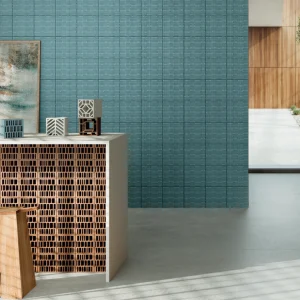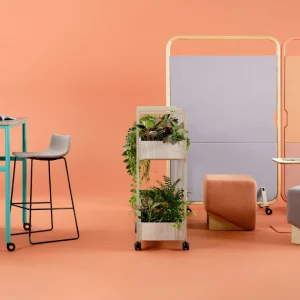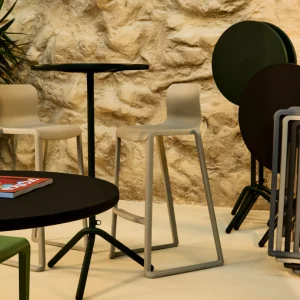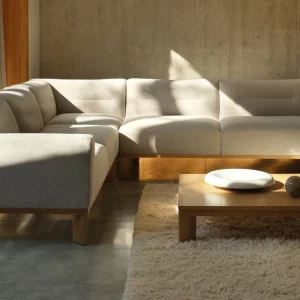
Q&A by Pamela Buxton
What does your current role at John Lewis entail?
I’m responsible for everything 3D to do with the selling environment – internal architecture, layouts, fixtures, finishes, lighting, and presentation standards (architects are appointed by the property services group). I’m not a designer myself but I manage a team of great designers. It’s a fantastic job.
How did you get into retail?
I always loved shops, so I applied to be on the management training scheme at Top Shop. My passion has always been setting out product in a way that makes customers want to shop.

The Heathrow store is a launch pad for international ambitions.
Do you have any particular design heroes, past or present?
Lucienne Day. I love vintage textiles and my love for her work started when I joined John Lewis – at that time Lucienne and Robin Day were design consultants to John Lewis.
Are you regularly approached by design teams?
Yes, and if they’ve done work I admire, it’s always good to meet them. Each year we normally pick a designer who is new to us to work with, especially for smaller jobs.
How do you go about commissioning designers and architects?
I like to have a balance between internal and external teams. We have an extensive and expert in-house design team that understands and loves the John Lewis brand, but there are some areas where you need specialist expertise, for example the catering areas.
On major projects we always ask three or four agencies to pitch. Sometimes, we have a competition for our internal teams. We’re currently working with Dalziel and Pow, GP Studio and RFK Architects, and have also worked with Virgile and Stone on our home departments. We try to freshen it up a bit but ultimately it’s about picking the right company for the right project. Appointments are always made in conjunction with the buying director for that project.

The new shop above Birmingham New Street station.
What qualities do you look for?
We’re looking for fresh ideas and thinking. Maybe they will have some quirky take to shake things up that we haven’t had internally, or they might have some particular experience in a specialist sector.
External designers have to love the brand and respect John Lewis, but also understand that we want to move forward. We do like to be challenged – we can’t stand still because the retail environment is revolutionising. Designers also have to be able to understand our business and see how they fit into the bigger picture.
What makes for a good retail environment and how has this changed with the advent of online shopping?
There’s been more change in the past five years than ever before, but the core principles of retail remain the same. Ease of shopping is still paramount so that means good orientation, navigation and facilities.
Without these, we’ve lost the customer. With customers able to shop online, the in-store experience has to work much harder to differentiate from purchasing over the internet.
Customers enjoy handling product, feeling the fabric and trying things on – all the things you can’t do online – and also the interaction with the partners, so we need to enable them to do this.
Shops have to become more of a social space. So our stores are about having the right catering offer and making dwell time more appealing. We’re turning up the dial so there is pretty clear water between the store and the online experience. We’re also working on how to make the online experience easier in-store. The melding of the two is the real business challenge.
How important is shop design to increasing sales?
Exceptionally important. A really great product will always sell itself. But getting brand loyalty so that your shop is the one that customers choose is a whole other challenge. It’s about differentiation, and design is one of the elements that has to play its part in order to create this.
What aspects of retail design are the hardest to get right?
Balancing cost and ambition. To be successful, design has to come at an affordable cost, yet be of the right quality. It’s also a challenge to juggle priorities and know how frequently you need to refresh a design.
What projects do you feel have turned out particularly successfully?
John Lewis Exeter – the first of our new format stores. Normally, full line stores are 14,000 sq m but Exeter was 6,000 sq m and arranged over six floors with small individual floorplates.
So the challenge was to make a compelling department store and really dial-up on the inspiration. We worked with Dalziel and Pow and I was thrilled with how it turned out. In April we opened York, and these are seeding an important new format for us.
What are the key design projects under way at the moment?
We are opening our first airport retail unit this month at Heathrow T2. This is about serving our customers at the airport and also seeding internationalCLIENT FILE ambitions. It’s 334 sq m and is being designed internally with some learnings from GP Studio. In Birmingham, we’re opening a full line department store above the railway station, and on Oxford Street we’ve been refurbishing the lower-ground floor to deliver a compelling cooking, dining and gifting offer.
Aside from John Lewis, do you have any particular favourite shops/stores?
There’s a shop in Tokyo called Okura that has a marvellous single-mindedness in its use of indigo fabric, which even covers the walls and stairs. It also has the very best product.





